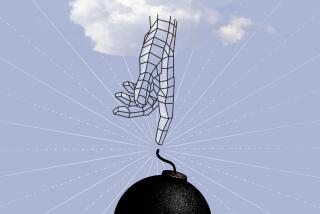Future and Past in a Transparent World
- Share via
Book clubs and discussion groups are going to feast on “The Light of Other Days.” Though it is only middlingly successful as a novel, it’s extraordinarily rich in ideas, for which Arthur C. Clarke (“2001: A Space Odyssey,” “Rendezvous With Rama”) and Stephen Baxter (“The Time Ships”) construct plausible scientific underpinnings.
For example: What if human beings lost all their privacy forever? In the 2030s, Seattle-based entrepreneur Hiram Patterson, the Bill Gates of his era, invents the WormCam. At a certain subatomic level of matter, tiny “wormholes” open up momentarily in the “quantum foam,” connecting any given point in space with any other. Patterson’s technicians, including his sons, David and Bobby, enlarge and stabilize these wormholes so that people can see through them.
Patterson’s aims are strictly mercenary. He owns a CNN-type news organization and wants to scoop his rivals without the expense of maintaining reporters and photographers around the globe. But the WormCam, once his firm and the government no longer monopolize it, proves to have much broader implications.
The world becomes transparent. Military and corporate secrecy vanish. Unfaithful spouses, charlatans and criminals are exposed. No bodily functions can be hidden. The 5th Amendment is meaningless. People must learn to live with the possibility of being spied on at every moment, just as the devout have believed themselves to be under the eye of God.
Is this catastrophe or utopia? Clarke and Baxter could have been satisfied with giving us that much to argue about--considering how nervous we are about current surveillance technology--but they’re just getting warmed up.
Never mind that a space rock 400 kilometers across has beendiscovered on a collision course with Earth. It will hit only 500 years hence, with a force many times greater than that of the comet that killed off the dinosaurs--casting the value of all human progress, including the WormCam, in doubt.
And never mind the thriller plot that involves Patterson, his megalomania, his sons’ mysterious parentage and journalist Kate Manzoni, who becomes Bobby’s lover against the old man’s wishes. That’s just a container, hardly more substantial than Styrofoam, for the scientific and historical speculation.
Yes, historical. Because space and time are ultimately one, the WormCam can also peer into the past. Humanity has hardly adjusted to the death of privacy when it must cope with the death of cherished illusions--no Robin Hood, no Moses; a Jesus very different from the figure in the Gospels; the terrible crimes committed by all nations seen in bloody, uncensored immediacy.
“Just as each human will now have to learn to construct a personality in the glare of pitiless WormCam inspection,” a congressional report in 2037 notes, “so communities will have to come to terms with the stripped-bare truth of their own past. . . . And the sooner we get on with it, the better.”
Young people adapt by becoming “Joined”--having WormCams implanted in their heads and linked to their cerebral cortexes. They can share perceptions and memories, see through one another’s eyes, exist as a kind of group mind--the next stage in evolution.
Again, Clarke and Baxter could have been satisfied. But it’s when David and Bobby, tracing their DNA back through the generations, leave history behind that “The Light of Other Days” truly hits its stride.
The extraordinary rarity of life, its extraordinary persistence through a series of planet-smashing events--in this context, even the spectacle of our remotest, one-celled ancestors takes on a kind of cosmic poetry. And just as “2001” ended with a surprise--the kaleidoscopic lights, the Mozart, the embryo--so does this story, in the deepest past, find an unexpected clue that the human race hasn’t run out of future after all.
More to Read
Sign up for our Book Club newsletter
Get the latest news, events and more from the Los Angeles Times Book Club, and help us get L.A. reading and talking.
You may occasionally receive promotional content from the Los Angeles Times.









